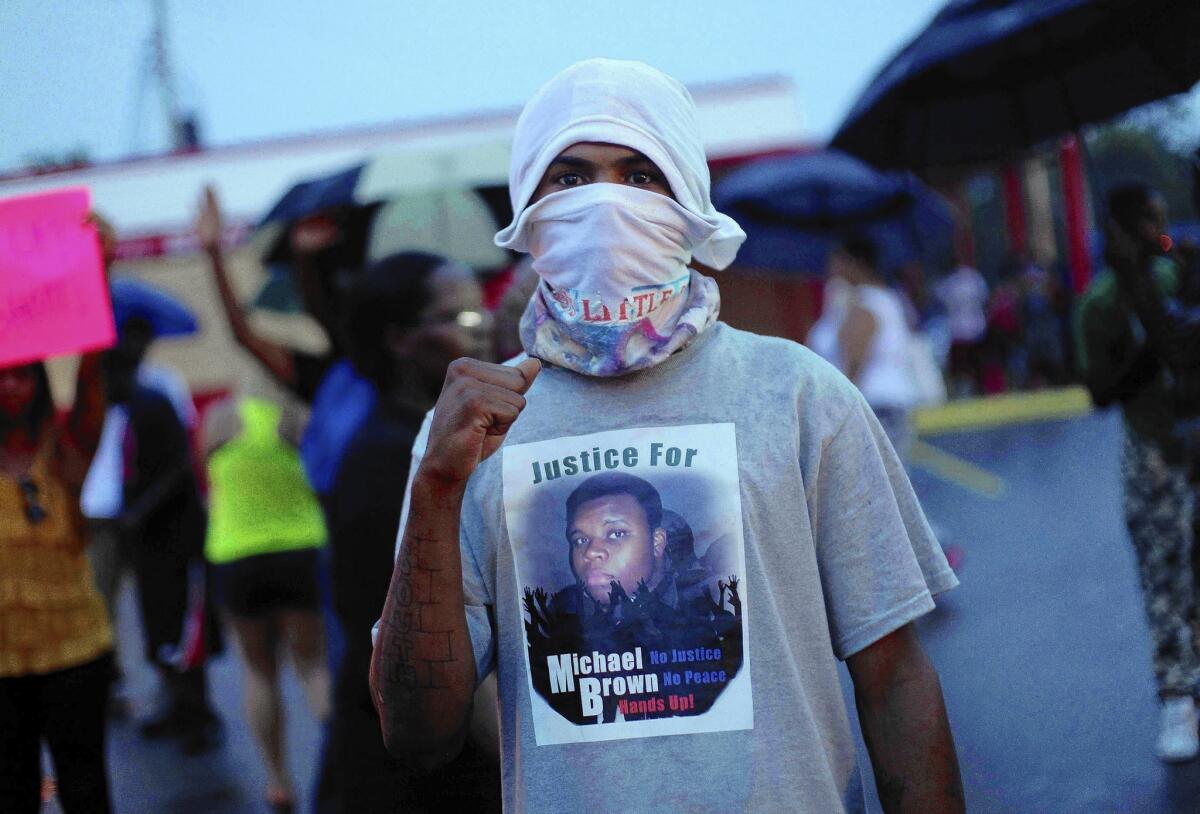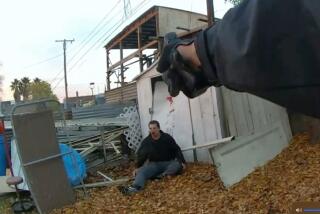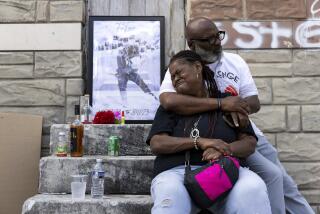Among Michael Brown’s neighbors, anger over a future lost

- Share via
Reporting from Ferguson, Mo. — To understand Michael Brown and why his shooting has unleashed such anger here, go to the place where he lived and died.
Canfield Green Apartments, a worn complex of brick buildings surrounded by trees and hills, has become a rallying point for protesters. They congregate at its center, Canfield Drive, the two-lane street where Brown, a black 18-year-old, died Aug. 9, shot multiple times by a white police officer.
The apartments are a working-class way station — a way out of the inner city, adjacent to the slightly pricier townhomes and tract houses.
“It’s not the projects, and it’s not Section 8, but it’s not townhomes, either,” said Lloyd Williams, 29, a friend of Brown’s family who works at a casino.
But amid the trappings of a working-class haven is an edge of frustration and anger.
Many of the young have no work. Some have served time in prison for violent crimes, including clashes with police. The apartment complex community had a tense relationship with Ferguson officers.
In this mix, Michael Brown was known as a good kid — not an angel, but someone who had hope for the future.
It is part of the reason why his death has reverberated so strongly: He had hope, and he was killed.
“If his grandma said go upstairs, he went. He was respectful,” recalled neighbor Kevin Seltzer, 30. “He didn’t bother people. That’s why the community here in Ferguson, the real community of Canfield, we’re upset now.”
Brown stayed at Canfield with friends and, earlier this year, with his grandmother at the adjacent Northwinds apartments. He had just graduated from nearby Normandy High School — no small achievement here.
He was heavyset and quiet, but not shy. He recorded rap music with his best friend and smoked marijuana with other young men.
Everyone called him “Mike-Mike.” He’s so big, they said, you have to call him twice. His cousin, Christine Ewings, said Brown had played on the high school football team but stopped because he was afraid of hurting smaller students.
Williams said he used to listen to Brown rap about improving his life as he was preparing to attend technical school, studying the heating and cooling trade. “He was bettering himself,” Williams said.
Brown didn’t have a car or license. Like many here, he walked to nearby stores, including on the day he was shot.
Seltzer watched him leave that day in a T-shirt, shorts and flip-flops. Brown was headed for a nearby minimart to buy cigarillos — cigars often used to smoke marijuana.
He stopped briefly to chat with two white landscapers who had been chopping down trees in the complex. They complained about the work, and Brown put it in perspective.
He told them “be thankful you have a job because some people don’t have jobs around here,” recalled Seltzer, who is among the unemployed.
Moments later, he said Brown departed with a friend, Dorian Johnson, 22, promising to be right back.
Police said that Brown then walked to a minimart and stole some cigarillos. Williams said he didn’t know whether that was true, but he said in this neighborhood it wouldn’t have marked Brown as much of a criminal. “When you’re growing up in a rough situation, everybody makes mistakes,” Williams said.
Brown was later shot after being confronted on Canfield Drive by police Officer Darren Wilson in front of several apartment residents.
A woman who lives in the complex and asked not to be identified for fear of being targeted by residents and police said she heard the commotion and ran to her balcony. She said Brown threw his hands up in the air, shouting, “Don’t shoot!”
“The officer kept shooting and he fell to his knees, begging for his life,” the woman said. “That’s when he finished him off, shot him in the head.”
The woman said she works in a warehouse and moved here in March with her 2-year-old daughter to escape the violence in inner-city St. Louis.
She knows hard-core criminals, and said that Brown wasn’t one. He was not a known drug dealer, not a gang-banger.
“His death just pushed a lot of people over the edge,” she said.
The simmering fear at the apartments has boiled over lately. Several residents have moved out, afraid of both demonstrators and the police.
“There’s a bad vibe around here now,” said the woman who witnessed the shooting. “I don’t feel safe.”
She emerged from her apartment Friday into the humid afternoon with her daughter following the sweet smell of barbecue to a free lunch in a tent set up by volunteers on the lawn across from an impromptu shrine set up on the street for Brown.
They retreated almost immediately. The night before there had been looting one street over on West Florissant Avenue. Now the governor had announced a curfew, and she was worried.
Kevin Brankley, 29, observed from the opposite side of the street, just as he had the day of Brown’s shooting.
Brankley said he grew up in a tough area of St. Louis, and was almost accustomed to seeing bodies in the streets. But this shooting startled even him, “movie-type” violence in broad daylight against a man he knew to be laid-back.
Brankley, a construction worker, said he planned to stay at the complex, where he hoped neighbors would continue to look out for one another.
He said he didn’t know Brown very well, but he added: “It’s not how good Mike was — it’s how corrupt the police is,” he said.
As a black man on these streets, “it doesn’t matter what you do,” he said. “You’re not liked or hated for what you do. You’re liked or hated for who you are.”
More to Read
Sign up for Essential California
The most important California stories and recommendations in your inbox every morning.
You may occasionally receive promotional content from the Los Angeles Times.










